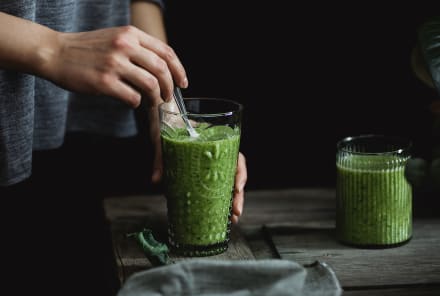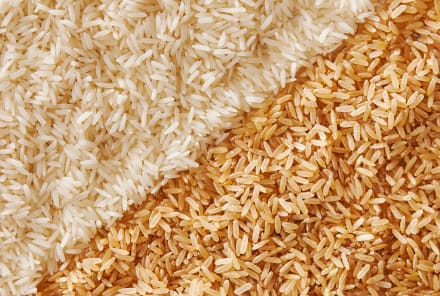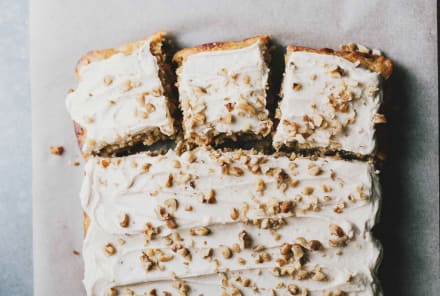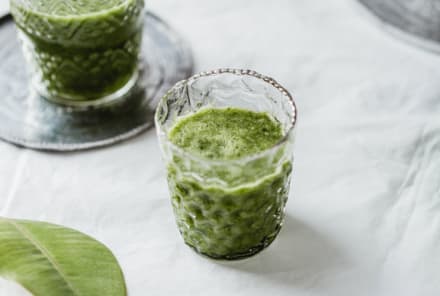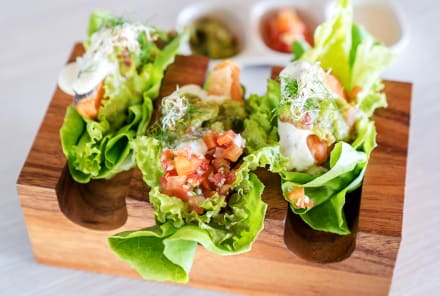Advertisement
This Is What A Day On A Plate Of A Super Gut-Healing Diet ACTUALLY Looks Like

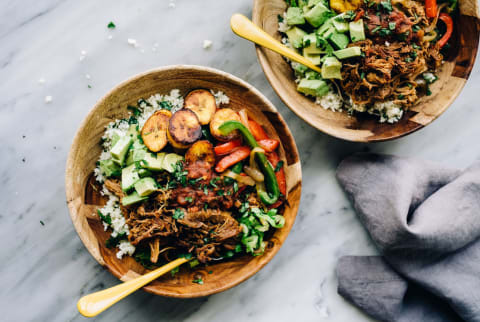
I struggled with IBS for years before finding a diet that healed my symptoms enough to help me live a normal, happy life: the low-FODMAP diet. It was developed at the Monash University in Australia, and it reduces fermentation in the gut, thereby reducing gas production, decreasing the distention of the bowel, and therefore reducing symptoms like constipation, bloating, and stomach pain.
So what is it, exactly? FODMAP is an acronym for short-chain carbohydrates, which are poorly absorbed in the small intestine.
It stands for Fermentable (the process through which gut bacteria break down undigested carbohydrate to produce gases like hydrogen, methane, and carbon dioxide) Oligosaccharides (fructo-oligosaccarides found in wheat, rye, onions and garlic) Galacto-oligosaccharides (found in legumes/pulses) Disaccharides (a lactose found in milk, soft cheese, and yogurts) Monosaccharide (fructose in excess of glucose found in honey and many fruits and vegetables) And Polyols (sugar polyols like sorbitol and mannitol, found in some fruit and vegetables and used as artificial sweeteners).
I've successfully used the low-FODMAP diet to heal my debilitating IBS, but one of the most common questions I get is what my day actually looks like. What am I eating? What food is left to eat? This is what a typical day of mine might look like. (Of course, this is just what works for me—as always, consult a doctor before making any radical dietary changes).
A day in the life of a low-FODMAP diet.
Breakfast
I wake around 7 a.m., having gone to bed at 11 p.m. Getting around eight hours of good-quality sleep a night in a solid routine is essential, since lifestyle factors like sleep, stress, and exercise affect my symptoms. I have my breakfast within 30 minutes of getting up. I've found that, for me and other IBS sufferers I know, it's best not to leave it any longer, because gas starts accumulating in an empty stomach.
I have IBS with constipation, so my breakfast is an attempt to get a good hit of fiber early on to facilitate an easy bowel movement. It consists of cranberry and almond muesli (a recipe from my new cookbook, The Low-FODMAP 6 Week Plan and Cookbook, shared below), ½ a kiwi fruit, ½ an almost green banana, lactose-free milk, and a dollop of lactose-, sugar-, and fruit-free yogurt.
I also have my daily cup of tea. While I prepare breakfast, I munch on a few baby carrots or celery to increase my fiber and get a serving of vegetables. I like to have vegetables in all five of my meals to get enough since I can't eat too many at any one meal.
Within 30 minutes of my breakfast, I have a bowel movement. If I have balanced my fiber well and consumed enough water during the previous day, this will be an easy exercise but will still take about 10 minutes. Patience is required.
Morning Snack
At about 10:30 a.m., I have a glass of water and a snack—perhaps some rice crackers with feta and tuna dip (from my cookbook, shared below) and ½ cup of cucumber.
I find that it's best not to leave longer than about four hours between meals to prevent gas accumulating once the digestion of the previous meal has finished. Between my morning snack and lunch, I go for a 30-minute walk. Studies have found1 that exercise increases colonic motility, transit time (that is, the time it takes for matter to pass through the colon), and transitive intestinal gas, thereby reducing the wind in the system that causes bloating.
Lunch
At about 1 p.m., I have lunch—usually leftover dinner from the night before along with a glass of water. I like to make sure that my meals are balanced with a source of protein, a vegetable, and a starch like a grain or starchy vegetable (like potato or sweet potato) at every meal, in order to prevent hunger pangs and blood sugar swings.
Afternoon Snack
At around 4 p.m., I have my afternoon snack—maybe a handful of permitted nuts (such as walnuts, almonds, or macadamia nuts), a low-FODMAP cookie (like the chocolate chip and peanut butter cookies from my cookbook, shared below), and ½ cup of fennel. I also have another glass of water. In total, I have eight glasses of water a day but always sip it rather than gulping it down, so the impact on the distention of my gut is minimal.
Dinner
Dinner is at about 7:30 p.m. in our household and varies considerably from one day to the next since I enjoy cooking and like to experiment. An example could be tuna pasta salad with snow peas and radishes (from my cookbook, shared below). I also include the usual glass of water. In my family, everyone eats a low-FODMAP meal together for dinner—if the rest of the family doesn't need to eat low-FODMAP, they can eat FODMAP foods during the rest of their day.
While it can feel like a lot, I always tell people to schedule your meals and then schedule your life, which is exactly the opposite of how most people do things. This constitutes quite a change in habits for the majority of those with IBS and will initially feel outside your comfort zone, but within a week, you will have adjusted to this new, healthy way of eating, and it will become second nature. The reward, ideally, is a calm gut, regular bowel movements, and a happier life free from fear of an episode.
Recipes
Cranberry & Almond Muesli
Muesli is a great breakfast staple, and it’s so convenient for busy mornings. Oats are high-fiber and may be too harsh for you, especially if you have IBS with diarrhea, so be sure to test your tolerance levels. On the other hand, though, oats can be an effective tool if you have IBS with constipation. Vary the nuts and spices according to taste, and serve with lactose-free milk, a low-FODMAP fruit, and lactose-free yogurt.
Serves 12
Ingredients
- 3 cups (240 g) instant oats
- 1 cup (120 g) dried cranberries
- 1 cup (110 g) toasted almond flakes
- ½ tablespoon (4 g) cinnamon
- ½ tablespoon (3 g) allspice
Method
Simply combine all the ingredients well and store in an airtight container for up to 1 month.
Feta & Tuna Dip
This rich, nourishing dip is a great snack-time partner for gluten-free crackers and vegetable sticks. You’ll notice on the Food Groups list that you can have ½ cup of feta at a time, but because it's blended to a cream here, have ¼ cup for your snack alongside 8 to 10 rice crackers and a nonstarchy vegetable. It's ideal for sharing, so offer it to guests with drinks, or bring it along as your contribution to a shared meal.
Serves 4
Ingredients
- 7 oz (200 g) feta cheese, broken into pieces
- 3.17 oz (90 g) canned tuna in spring water, drained
- ½ teaspoon wasabi
- ½ celery stalk, roughly chopped
- 1 tablespoon (3 g) chives, roughly chopped
- 2 tablespoons (15 g) walnuts
Method
- Place the feta in a food processor.
- Add the tuna and wasabi, and blend well until the mixture becomes a smooth paste. Add the celery, chives, and walnuts, and pulse again to combine (but do not over blend).
- Place the dip in the fridge to set, about 2 hours, before serving. Store in the fridge for 2 to 3 days.
Chocolate Chip & Peanut Butter Cookies
One cookie is the serving size for these addictive treats, so freeze the rest of the batch so you can enjoy them later. Even though they contain sugar, I consider them to be "healthy" treats because of the other ingredients. It's still important to limit your sugar intake and get as much of it from fresh fruits as possible, which is why I don't have more than one per day.
Make 12 cookies
Ingredients
- 1 cup (80 g) instant oats
- ¼ cup (24 g) almond meal
- ¾ cup (64 g) shredded coconut
- 1 cup (175 g) chocolate chips
- ¼ cup (40 g) white rice flour
- ⅛ cup (16 g) tapioca flour
- ⅛ cup (24 g) potato starch
- ¾ teaspoon baking powder
- ¾ teaspoon baking soda
- Pinch of salt
- 1 cup (260 g) sugar-free peanut butter
- ¼ cup (59 mL) oil
- ½ cup (100 g) white sugar
- ¼ cup (80 g) maple syrup or golden syrup
- 2 eggs
- 1 teaspoon vanilla extract
Method
- Preheat the oven to 350°F (180°C, or gas mark 4).
- Combine the oats, almond meal, coconut, and chocolate chips in a large bowl.
- Sift the flours, potato starch, baking powder, baking soda, and salt into the oat mixture.
- Combine the peanut butter, oil, sugar, syrup, eggs, and vanilla in a separate bowl to form a smooth mixture. Add the wet ingredients to the dry and blend lightly.
- Drop the dough by rounded teaspoonfuls onto a baking tray lined with baking paper.
- Push each round of dough into a circular shape and flatten a little. Bake for 6 to 8 minutes or until golden on top. Transfer to a wire cooling rack and let cool until firm. Store in an airtight container for 2 to 3 days, or freeze for 2 to 3 months.
Tuna Pasta Salad With Snow Peas & Radishes
Packed with tuna and crunchy, low-FODMAP vegetables, this pasta salad is another quick weeknight meal. Substitute salmon or any other canned fish for the tuna, or use another type of mature cheese in place of the Brie, and have up to a quarter of this recipe per serving. Leftovers make great lunches or dinners for the following day—just be sure to adjust your serving size so you don't exceed your FODMAP limits.
Serves 4
Ingredients
- 2 cups gluten-free pasta
- 6.5 oz (185 g) canned tuna (in spring water), broken into chunks
- 4.4 oz (125 g) Brie, roughly chopped
- ½ cup (60 g) roughly chopped walnuts
- ½ cup (25 g) bean sprouts
- 2 cups (60 g) baby spinach
- 5 radishes, roughly chopped
- 10 snow peas
- 3 tablespoons (42 g) garlic- and onion-free mayonnaise
- Juice of ½ orange
- 1 tablespoon (15 mL) lemon juice
- Salt and pepper
- 1 tablespoon (4 g) fresh oregano
Method
- Cook the pasta in boiling water until al dente.
- Drain and rinse with cold water to cool it down. Place in a serving bowl.
- Drain the tuna and add it to the bowl, followed by the Brie, walnuts, and vegetables.
- Combine the mayonnaise with the orange and lemon juices. Mix in the oregano, and season to taste. Spoon over the salad, and mix gently to coat all the ingredients. Serve immediately. Store leftovers in the fridge for up to 2 days.
Recipes excerpted from The Low-FODMAP 6-Week Plan and Cookbook by Suzanne Perazzini, with the Quarto Publishing Group. Copyright © 2018.
Watch Next
Enjoy some of our favorite clips from classes
Enjoy some of our favorite clips from classes
What Is Meditation?
Mindfulness/Spirituality | Light Watkins
Box Breathing
Mindfulness/Spirituality | Gwen Dittmar
What Breathwork Can Address
Mindfulness/Spirituality | Gwen Dittmar
The 8 Limbs of Yoga - What is Asana?
Yoga | Caley Alyssa
Two Standing Postures to Open Up Tight Hips
Yoga | Caley Alyssa
How Plants Can Optimize Athletic Performance
Nutrition | Rich Roll
What to Eat Before a Workout
Nutrition | Rich Roll
How Ayurveda Helps Us Navigate Modern Life
Nutrition | Sahara Rose
Messages About Love & Relationships
Love & Relationships | Esther Perel
Love Languages
Love & Relationships | Esther Perel

